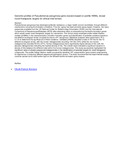| dc.contributor.author | Kirsteen, Okoth Patrick | |
| dc.date.accessioned | 2021-06-03T14:04:29Z | |
| dc.date.available | 2021-06-03T14:04:29Z | |
| dc.date.issued | 2021-04 | |
| dc.identifier.uri | https://doi.org/10.5897/JBSA2020.0114 | |
| dc.identifier.uri | https://www.researchgate.net/publication/350640281_Genomic_Profiles_of_Pseudomonas_aeruginosa_Gene_Clusters_Based_on_Profile_HMMs_Reveal_Novel_Therapeutic_Targets_for_Clinical_Intervention | |
| dc.identifier.uri | http://r-library.mmust.ac.ke/123456789/1583 | |
| dc.description.abstract | Pseudomonas aeruginosa has developed antibiotic resistance, a major health concern worldwide, through different mechanisms including the formation of biofilms. Thus far, typing has been primarily assay based. However, the many sequences available from the US National Center for Biotechnology Information (NCBI) and the International Consortium of Pseudomonas Database (IPCD) offer alternative ways of characterizing the biofilm formation genes which would reveal novel therapeutic targets for intervention. The current study employed profile hidden Markov models (pHMMs) in the characterization of biofilm formation genes and identification of possible variations based on the different ecological niches occupied by strains of P. aeruginosa. Statistical analyses were performed in R (v. 3.1.3) to determine the significance of these variations. Validated pHMMs identified a total of 197 hits for the 13 different ecological niches, with the human metagenomes recording 144 hits (73%) while the non-human metagenomes recorded 53 hits (27%). Human metagenomes had a significantly higher density of hits, with the abscess metagenomes indicating the highest density of hits. The overall result indicated a significant variation in density of hits between the different sites within the human metagenomes. This study successfully highlighted the significant value of already sequenced metagenomes in the identification of potential targets for novel therapeutic compounds. The profile hidden Markov model successfully identified 197 unique biofilm gene clusters emphasizing its importance in analyzing different sequenced pathogenic strains. The study recommends that experimental assays could be carried out to shed further light on the different biofilm formation gene clusters. | en_US |
| dc.language.iso | en | en_US |
| dc.publisher | Journal of Bioinformatics and Sequence Analysis | en_US |
| dc.subject | Genomic,Pseudomonas, aeruginosa, gene clusters, profile HMMs, reveal, novel, therapeutic, clinical, intervention. | en_US |
| dc.title | Genomic profiles of Pseudomonas aeruginosa gene clusters based on profile HMMs, reveal novel therapeutic targets for clinical intervention. | en_US |
| dc.type | Article | en_US |

